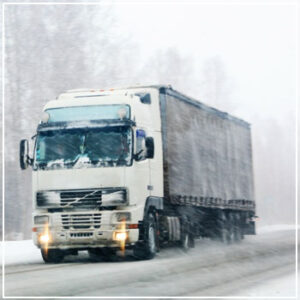As a driver in New England, you know how the roads can get in winter: Slick and slippery until they are plowed after a snowstorm. For commercial truck drivers, the dangers of driving on ice and snow are multiplied. Although these drivers have an advanced skill set in terms of vehicle maneuverability and skid control, they also have to factor in the behavior of the other drivers around them, which can make winter travel more challenging.
Keep the following tips in mind to help keep yourself and truck drivers safe on the roads.
1. Never Speed or Tailgate
 No driver should travel fast in icy, snowy conditions, but large truck drivers will be traveling well below the speed limit. Remember that the size of these vehicles make it harder to stop on a dime, so these drivers will be slow in the snow for everyone’s safety. All drivers should travel at a safe speed and leave plenty of room around the vehicle. Truck drivers like to keep a good distance between themselves and other vehicles in front and along the sides, so it’s not recommended for other drivers to travel too close to this space.
No driver should travel fast in icy, snowy conditions, but large truck drivers will be traveling well below the speed limit. Remember that the size of these vehicles make it harder to stop on a dime, so these drivers will be slow in the snow for everyone’s safety. All drivers should travel at a safe speed and leave plenty of room around the vehicle. Truck drivers like to keep a good distance between themselves and other vehicles in front and along the sides, so it’s not recommended for other drivers to travel too close to this space.
The general rule of thumb with following trucks is that if you can’t see their mirrors, you are driving too close. It’s very dangerous to tailgate other vehicles, especially in inclement weather conditions. Large trucks need more distance and time to stop, so other drivers should be several car lengths behind, in case a truck ahead suddenly applies its brakes.
2. Do Not Pass Large Trucks
Tractor trailer trucks make wider turns than passenger vehicles. While you may be able to pass a sedan making a righthand turn, never attempt this maneuver with a truck. Especially in snow and ice, the trailer could fishtail on a slippery surface. Allow the truck it needs to turn, before safely proceeding on your journey.
Another reason to keep your distance and never pass a truck in wintry conditions is the potential danger of braking. During a snowstorm, trucks have an increased risk of jack-knifing. Professional truck drivers know to apply the brakes when the truck and trailer are straight but if the tires hit black ice, a spinout may be unavoidable. If you’re attempting to pass, your vehicle could be hit.
3. Is Your Vehicle Ready for Snow?
Both car and truck drivers should make sure their vehicles are set to go before heading out into the snow. From fluid top-offs to repairs, what should you look for?
- Make sure the wipers and lights are all working.
- Top off the washer fluid and fuel tank.
- The brakes and windows should be set up and completely clean.
- Make sure your tires have tread.
- The defroster and heater should both be operating correctly.
- Post-storm, all ice and snow need to be cleaned off.
- Have kitty litter or sand on-hand to help with traction or frozen tires.
When drivers do not consider the risk factors of snow and ice before hitting the road, severe accidents can occur. Were you hit by another car or truck while traveling in wintry conditions? To pursue a claim, contact Trantolo & Trantolo’s truck accident attorneys today.


